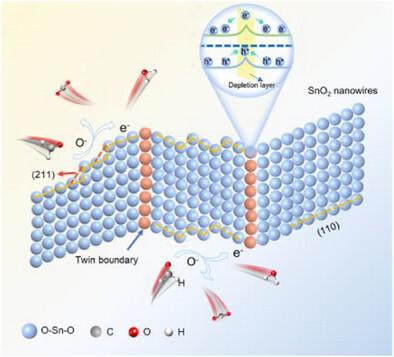Synergistic Effect of High-Energy (211) Facets and (101) Twin Defects of SnO2 Nanowires for Ultrasensitive ppb-Level Formaldehyde Monitoring
IF 19
1区 材料科学
Q1 CHEMISTRY, MULTIDISCIPLINARY
引用次数: 0
Abstract
SnO2 gas sensors have attracted significant interest for formaldehyde detection due to their real-time monitoring capabilities, cost-effectiveness, and portability. However, low sensitivity, poor selectivity, and limited long-term stability remain critical challenges for trace-level formaldehyde detection. Here, the synthesis of SnO2 nanowires with preferentially exposed high-energy (211) facets and abundant (101) twin defects via a solvothermal approach is reported. Gas-sensing evaluations revealed that sensors constructed from these nanowires, particularly those with maximized exposure of (211) facets and (101) twin defects, exhibited an impressive response of 15.2 toward 10 ppm formaldehyde. Notably, these sensors demonstrated exceptional selectivity for formaldehyde against interfering gases, including methanol, toluene, ammonia, formic acid, acetone, and ethanol, with a detection limit as low as 59 ppb and robust long-term stability. The enhanced formaldehyde sensing performance is attributed to two synergistic effects: i) the increased density of active sites for oxygen adsorption on the high-energy (211) crystal facets, which possess abundant atomic steps, and ii) the Schottky barrier at the twin boundaries, which broadens the depletion layer and accelerates electron transfer through its intrinsic electric field. These findings highlight the promising strategy of engineering high-energy crystal facets and twin defects to significantly elevate the gas-sensing performance of semiconductor nanomaterials.

高能(211)面和(101)双缺陷对SnO2纳米线超灵敏ppb级甲醛监测的协同效应
SnO2气体传感器因其实时监测能力、成本效益和便携性而引起了人们对甲醛检测的极大兴趣。然而,低灵敏度、低选择性和有限的长期稳定性仍然是微量甲醛检测的关键挑战。本文报道了采用溶剂热法合成具有优先暴露高能(211)面和丰富(101)孪晶缺陷的SnO2纳米线。气敏评估显示,由这些纳米线构建的传感器,特别是那些最大暴露于(211)面和(101)双缺陷的纳米线,对10 ppm甲醛的响应值为15.2。值得注意的是,这些传感器对甲醛对干扰气体(包括甲醇、甲苯、氨、甲酸、丙酮和乙醇)具有出色的选择性,检测限低至59 ppb,具有强大的长期稳定性。增强的甲醛传感性能归因于两种协同效应:1)具有丰富原子台阶的高能(211)晶体表面上氧吸附活性位点密度的增加;2)孪晶界上的肖特基势垒拓宽了耗尽层,并通过其本征电场加速了电子转移。这些发现强调了工程高能晶面和双缺陷来显著提高半导体纳米材料气敏性能的有前途的策略。
本文章由计算机程序翻译,如有差异,请以英文原文为准。
求助全文
约1分钟内获得全文
求助全文
来源期刊

Advanced Functional Materials
工程技术-材料科学:综合
CiteScore
29.50
自引率
4.20%
发文量
2086
审稿时长
2.1 months
期刊介绍:
Firmly established as a top-tier materials science journal, Advanced Functional Materials reports breakthrough research in all aspects of materials science, including nanotechnology, chemistry, physics, and biology every week.
Advanced Functional Materials is known for its rapid and fair peer review, quality content, and high impact, making it the first choice of the international materials science community.
 求助内容:
求助内容: 应助结果提醒方式:
应助结果提醒方式:


